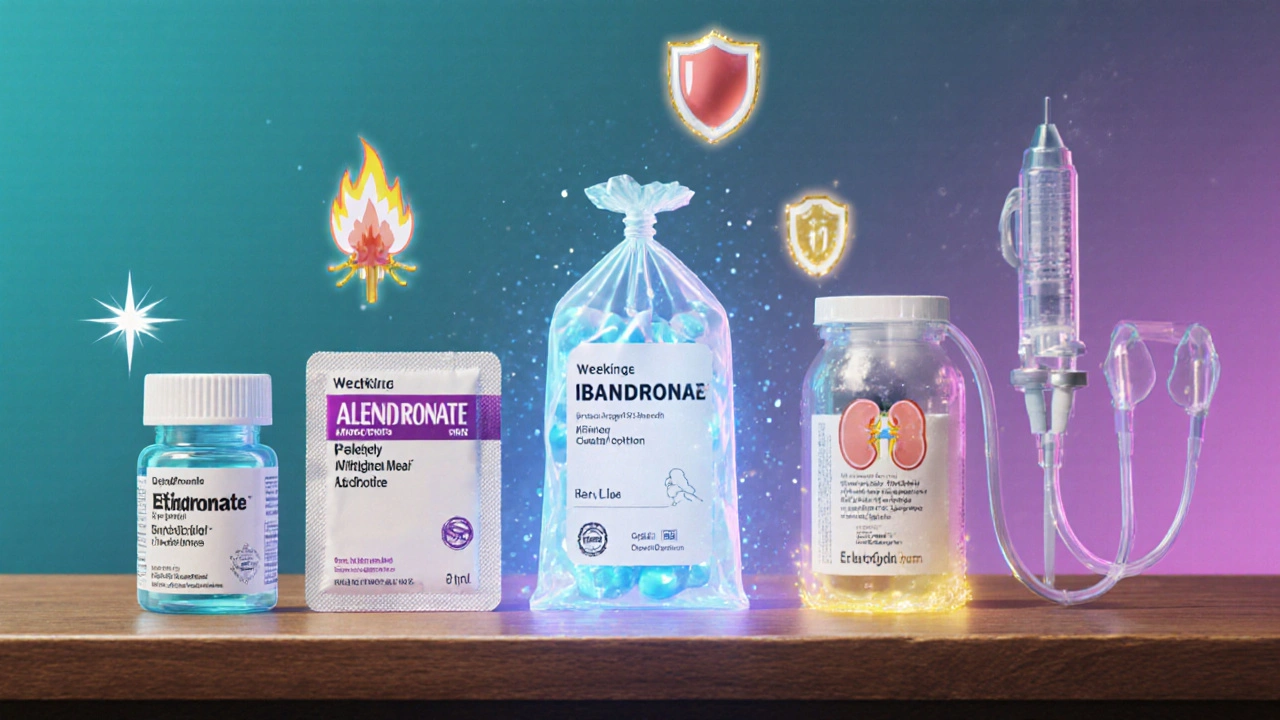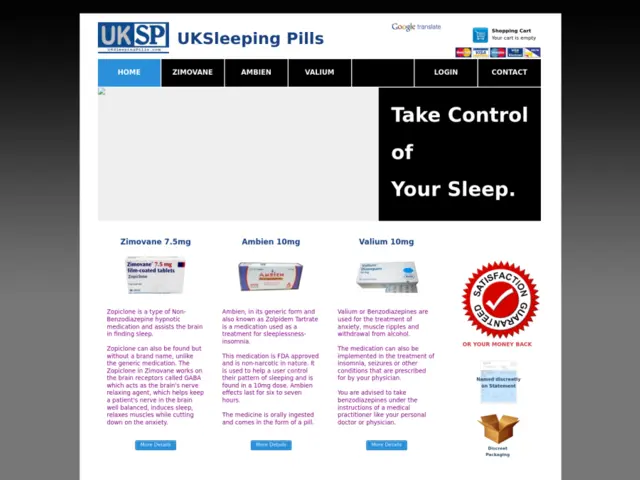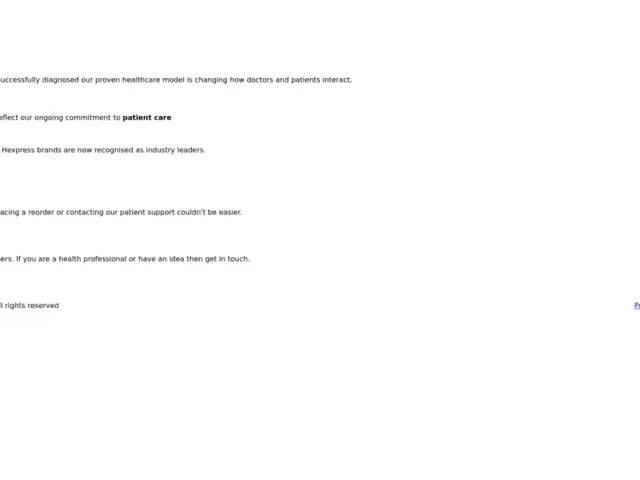Quick Takeaways
- Didronel (Etidronate) is a first‑generation bisphosphonate mainly used for Paget’s disease and preventing heterotopic ossification.
- Newer bisphosphonates such as Alendronate or Zoledronic acid offer once‑weekly or once‑yearly dosing and stronger bone‑resorption inhibition.
- Side‑effect profiles differ: Didronel can cause gastrointestinal irritation, while newer agents may trigger acute‑phase flu‑like reactions.
- Cost in Australia varies widely - generic Etidronate is inexpensive, but some newer options are subsidised under the PBS.
- Choosing the right drug depends on indication, kidney function, dosing convenience, and personal tolerance.
What is Didronel (Etidronate)?
When you see Didronel (Etidronate) is a first‑generation bisphosphonate approved to treat Paget’s disease of bone and to prevent heterotopic ossification after orthopedic surgery. It was introduced in the 1970s and remains available as a generic tablet in Australia.
The drug works by binding to hydroxyapatite crystals in bone, making those surfaces less attractive for osteoclasts. The result is a slower breakdown of old bone and a modest increase in bone density. Because its binding affinity is lower than that of newer bisphosphonates, Etidronate requires higher daily doses (typically 400 mg) and a longer treatment course (often 3‑6 months) to achieve noticeable effects.
How Does Didronel Work?
The active ingredient, etidronic acid, mimics the naturally occurring pyrophosphate that regulates mineralisation. By inserting itself into the crystal lattice, it disrupts the enzymatic process osteoclasts use to dissolve bone. This inhibition is reversible - once the drug is stopped, bone turnover gradually returns to baseline.
Because Etidronate’s affinity for bone is modest, it also circulates more freely in the bloodstream, which can lead to gastrointestinal side effects if taken without food. Patients are usually advised to take the tablet with plenty of water and remain upright for at least 30 minutes.
Key Alternatives to Didronel
Newer bisphosphonates have been engineered to stick tighter to bone, offering stronger anti‑resorptive power and more convenient dosing. Below are the most common alternatives you’ll encounter in Australian pharmacies:
- Alendronate - a second‑generation bisphosphonate taken weekly (or monthly) for osteoporosis and Paget’s disease.
- Risedronate - similar to Alendronate but available in a daily low‑dose tablet for patients who struggle with weekly dosing.
- Ibandronate - given intravenously once every three months, useful for those who cannot tolerate oral tablets.
- Zoledronic acid - a potent IV bisphosphonate administered once a year for osteoporosis or once every 2‑3 years for Paget’s disease.
- Pamidronate - an IV drug mainly used for hypercalcaemia of malignancy, but occasionally prescribed off‑label for severe Paget’s.
- Strontium ranelate - not a bisphosphonate but an alternative bone‑forming agent for osteoporosis.
- Calcium supplement - basic mineral support that works best when paired with vitamin D.
- Vitamin D - essential for calcium absorption; often co‑prescribed with any bone‑active medication.

Side‑Effect Snapshot: Didronel vs Alternatives
Understanding tolerability helps you weigh options. Below is a concise side‑effect comparison based on clinical data and Australian prescribing information:
- Didronel - gastrointestinal upset (nausea, abdominal pain), rare esophagitis if tablets linger in the throat.
- Alendronate - esophageal irritation, atypical femur fractures with long‑term use, osteonecrosis of the jaw (ONJ) in rare cases.
- Risedronate - similar to Alendronate but slightly lower esophageal risk.
- Ibandronate - acute‑phase reaction (fever, muscle aches) after IV infusion, transient flu‑like symptoms.
- Zoledronic acid - most common acute‑phase reaction after infusion, possible kidney function impact; monitor creatinine.
- Pamidronate - nausea and transient hypocalcaemia, especially after fast IV pushes.
- Strontium ranelate - increased risk of cardiovascular events; contraindicated in patients with prior heart disease.
Comparison Table: Didronel and Common Alternatives
| Drug | Generation | Typical Indication | Dose & Frequency | Route | Common Side Effects | Approx. PBS Cost (AU$) |
|---|---|---|---|---|---|---|
| Didronel (Etidronate) | 1st | Paget’s disease, heterotopic ossification | 400 mg daily for 3‑6 months | Oral | GI irritation, rare esophagitis | ≈ $12 (generic) |
| Alendronate | 2nd | Osteoporosis, Paget’s | 70 mg weekly or 10 mg daily | Oral | Esophageal irritation, atypical fracture | ≈ $30 (PBS‑subsidised) |
| Risedronate | 2nd | Osteoporosis | 35 mg weekly or 5 mg daily | Oral | Stomach upset, rare ONJ | ≈ $28 (PBS‑subsidised) |
| Ibandronate | 2nd | Osteoporosis | 3 mg IV every 3 months | IV | Flu‑like reaction, transient hypocalcaemia | ≈ $250 per infusion |
| Zoledronic acid | 3rd | Osteoporosis, Paget’s | 5 mg IV yearly (osteoporosis) or 4 mg IV every 2‑3 years (Paget’s) | IV | Acute‑phase reaction, renal monitoring needed | ≈ $320 per infusion (PBS‑subsidised) |
| Pamidronate | 2nd | Hypercalcaemia of malignancy, severe Paget’s | 30 mg IV weekly | IV | Nausea, hypocalcaemia | ≈ $150 per course |
| Strontium ranelate | Non‑bisphosphonate | Osteoporosis (EU only) | 2 g daily | Oral | Cardiovascular events, DVT | ≈ $200 (not PBS‑listed) |
Pros and Cons: Didronel Compared to Each Alternative
Below is a quick pros‑cons matrix to help you visualise trade‑offs.
- Didronel
- Pros: inexpensive, well‑studied for Paget’s, oral administration.
- Cons: requires daily dosing, less potent, GI side effects.
- Alendronate
- Pros: weekly dosing, strong efficacy for osteoporosis, PBS‑subsidised.
- Cons: esophageal irritation, rare atypical fractures with long use.
- Risedronate
- Pros: flexible dosing (daily or weekly), slightly better GI tolerance.
- Cons: similar rare ONJ risk, still requires upright posture after intake.
- Ibandronate
- Pros: no daily pill, convenient quarterly IV.
- Cons: requires clinic visit, acute‑phase flu‑like symptoms.
- Zoledronic acid
- Pros: once‑yearly (or less) dosing, highest bone‑resorption inhibition.
- Cons: IV infusion, renal function monitoring, possible fever post‑infusion.
- Pamidronate
- Pros: effective for severe cases, rapid calcium reduction.
- Cons: IV, limited availability, nausea common.
- Strontium ranelate
- Pros: dual action - builds bone and reduces resorption.
- Cons: cardiovascular risk, not covered by PBS, not a bisphosphonate.
How to Choose the Right Medication
Choosing isn’t just about price; you need to match the drug to your medical picture. Ask yourself these questions:
- What is the primary diagnosis? Paget’s disease often responds well to Etidronate, while osteoporosis benefits more from Alendronate or Zoledronic acid.
- How is my kidney function? IV bisphosphonates (Zoledronic, Ibandronate) require a creatinine clearance >30 mL/min. Etidronate is gentler on kidneys.
- Can I stick to a daily pill? If daily adherence is tough, weekly (Alendronate) or yearly (Zoledronic) may be safer.
- Do I have a history of gastrointestinal issues? Etidronate’s GI irritation can be mitigated with food, but patients with severe reflux may prefer IV options.
- What does my insurance cover? In Australia, many bisphosphonates are PBS‑listed; check the latest schedule for subsidy levels.
Bring these points to your GP or specialist. They’ll run blood tests (calcium, phosphate, renal panel) and may order a bone scan before committing to a long‑term plan.
When to Re‑evaluate Your Treatment
Even the best‑matched drug can lose its punch. Schedule a review after:
- 6 months of Etidronate - check alkaline phosphatase levels for Paget’s response.
- 1 year of Alendronate - repeat DXA scan to see if bone density has improved.
- Any IV bisphosphonate infusion - monitor serum creatinine 48 hours later.
If you notice new joint pain, jaw discomfort, or unusual fractures, contact your doctor immediately. Early detection of ONJ or atypical femur fractures can prevent serious outcomes.
Frequently Asked Questions
Can I take Didronel and calcium supplements together?
Yes. Calcium improves bone health and does not interfere with Etidronate’s absorption. Take calcium at a different time of day (e.g., breakfast) and the Didronel tablet with a full glass of water before a meal.
Is Etidronate safe for people with kidney disease?
Etidronate is cleared mostly by the kidneys, so doctors usually avoid it if the estimated glomerular filtration rate (eGFR) is below 30 mL/min. For moderate impairment (eGFR 30‑60), a dose reduction may be considered.
Why do newer bisphosphonates require less frequent dosing?
They bind more tightly to bone mineral, so a single dose lasts months or years. This high affinity also means stronger inhibition of osteoclasts, allowing spaced‑out administration.
What should I do if I experience esophageal irritation with Alendronate?
Stop the tablet, drink plenty of water, and stay upright for at least 30 minutes. Discuss switching to a weekly or IV option with your doctor.
Is there any advantage of taking Vitamin D with a bisphosphonate?
Vitamin D boosts calcium absorption, which helps bisphosphonates work more effectively. Most clinicians recommend 800-1000 IU daily alongside bone‑active drugs.
Armed with these details, you can now weigh Didronel comparison points against other options and have a focused conversation with your healthcare provider. The right choice hinges on your condition, lifestyle, and how your body tolerates each medication.





Olivia Harrison - 24 October 2025
Choosing the right bisphosphonate hinges on your diagnosis and lifestyle.
When I first looked at bisphosphonates I was overwhelmed by the dosing schedules and side‑effects.
The key, as you highlighted, is matching the drug to the patient’s specific condition and comorbidities.
For Paget’s disease, Etidronate remains a solid, budget‑friendly option that most GPs can prescribe without a PBS approval.
Its daily 400 mg regimen can feel tedious, but taking it with a full glass of water and staying upright for half an hour really tames the GI upset.
If a patient has reflux or a sensitive stomach, the newer agents such as Alendronate or Risedronate often cause less irritation because they’re taken less frequently.
However, the trade‑off is the increased risk of esophageal irritation if the tablet isn’t taken correctly.
For those who can’t swallow pills or have adherence issues, the IV choices like Ibandronate or Zoledronic acid remove the daily reminder altogether.
Just remember that IV bisphosphonates demand a baseline renal function check and a short post‑infusion observation period.
The acute‑phase flu‑like reaction that sometimes follows Zoledronate is usually mild and resolves within a couple of days with NSAIDs.
In terms of cost, the generic Etidronate is the cheapest, but the PBS subsidies for Alendronate and Zoledronic acid often level the playing field for many Australians.
From a safety perspective, the rare but serious events like osteonecrosis of the jaw and atypical femur fractures are primarily linked to long‑term use of the more potent agents.
That’s why regular drug holidays or therapeutic switches after a few years can be a prudent strategy.
Ultimately, a shared decision‑making conversation with your GP-reviewing calcium, vitamin D status, renal labs, and personal lifestyle-will pinpoint the best fit.
Feel free to bring this table to your next appointment; it makes the discussion concrete and evidence‑based.
Bianca Larasati - 27 October 2025
Imagine walking into the clinic armed with confidence, knowing you’ve got the perfect bone‑friend in your pocket!
This isn’t just any medication talk-it's a rallying cry for taking control of your skeletal destiny.
The daily rhythm of Etidronate can feel like a chore, but picture the triumph when your alkaline phosphatase finally drops.
Swap that dread for a win by pairing it with vitamin D and calcium, and watch your bones thank you.
Every pill becomes a tiny victory dance toward stronger, pain‑free days.
ram kumar - 29 October 2025
One must admit that presenting a table of numbers does little to elevate the discourse beyond a pharmacy brochure.
The pretentious enumeration of side‑effects feels like an academic exercise rather than compassionate guidance.
Moreover, the omission of real‑world adherence data renders the comparison almost frivolous.
In short, the piece skirts the deeper ethical considerations of prescribing.
Ken Dany Poquiz Bocanegra - 31 October 2025
What truly matters is aligning the medication’s pharmacokinetics with the patient’s daily rhythm.
A concise evaluation helps avoid unnecessary complexity.
Choosing wisely leads to better outcomes and fewer interruptions.
Tamara Schäfer - 3 November 2025
Thinking about bisphosphonates can feel like navigating a labyrinth, but every turn offers a lesson.
Didronel, while old, still holds a place for those who value cost and simplicity.
Newer agents bring convenience, yet they demand vigilance for rare side‑effects.
Balancing these factors is akin to solving a puzzle where each piece matters.
Remember to check your kidney function; it’s a small step that saves big trouble later.
In the end, the right choice reflects both science and personal circumstance.
Tamara Tioran-Harrison - 5 November 2025
It is utterly astounding how a humble table can masquerade as a breakthrough, isn't it? 🤔
One must, of course, applaud the lofty ambition while simultaneously noting the absence of any discussion on long‑term adherence.
The formal tone, however, does little to conceal the fact that the data merely rehashes known facts.
Nevertheless, the PBS cost comparison might prove useful to the fiscally‑conscious reader.
Yours sincerely, a connoisseur of medical literature. :)
kevin burton - 7 November 2025
The overview gives a clear picture of each drug’s strengths and limitations.
For patients worried about stomach issues, the newer oral bisphosphonates are worth a look.
IV options simplify dosing but require kidney checks.
Overall, the guide helps simplify a complex decision.
Benjamin Sequeira benavente - 10 November 2025
Take action now-pick the regimen that fits your life and stick with it.